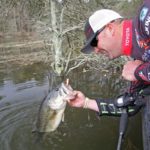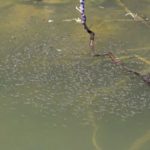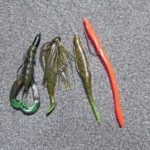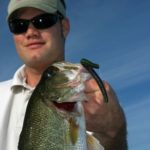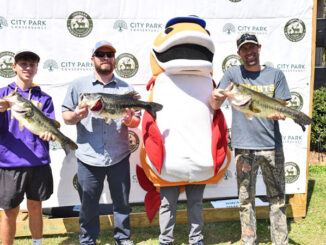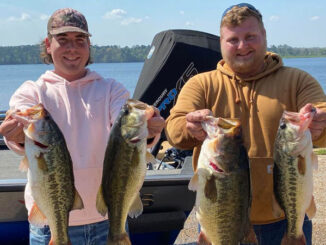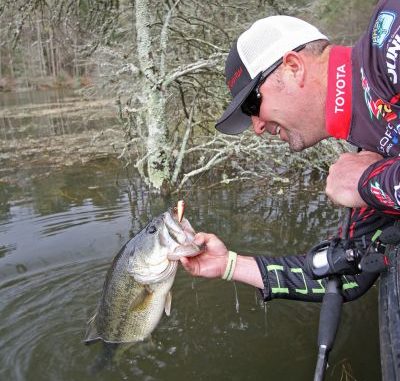
When the big females give up their beds, aggressive males remain to guard the next generation of bass. Here are some pointers on how to put those guarding papas in the boat.
Ponder the local playground: Kids laughing and chatting as they enjoy swing sets, merry-go-rounds, play sets, etc., while parents watch with a blend of heart-thumping pride and diligent protection.
It’s the same deal with baby bass — especially the brand-new ones we call “fry.”
New to the world, inexperienced and highly vulnerable, these little guys need 24/7 supervision. That’s why papa bass stays close until the little ones are big enough to figure out where to find food, where to find shelter and how to avoid the bream, turtles and birds that want to eat them.
Compelled to dissuade any would-be attackers, fry-guarding male bass present popular postspawn targets while the big females are resting and recuperating in deeper water.
Consider these points during this baby bass nursery stage:
The Job
Orders from mama bass probably read something like this: “Forget about your appetite; take care of the young’uns.”
And Toledo Bend guide Darold Gleason said the instructions are followed to the letter.
“The little males are very aggressive,” Gleason said. “Typically, if anything spooks the fry, they jump all over it.”
Bassmaster Elite Series pro Gerald Swindle agreed, but pointed out that these attacks are nothing like the amped-up feeding bites with which bass crush frogs over weed mats or football heads on a main-lake point.
“They’re not always trying to eat everything — they’re just trying to push it away,” Swindle said.
Habitat
Stumps, laydowns, shallow docks, grass lines and floating weed mats are the common fry gathering spots.
“That bass is just moving that fry to where he thinks they’ll be safest,” Swindle said. “I think when you go into a pocket, you have to be open-minded. Sometimes, it’s just the shade of an overhanging bush. It’s not the bushes they’re in — it’s the shade.
“It’s simply something to hide them.”
Depth
Look for fry to cluster fairly shallow for a few reasons.
First, the young need sunlight to keep warm and cozy while they grow and toughen.
And, pragmatically, guarding males can better keep the little guys rounded up when they don’t have so far to wander.
Also, deep water means danger, as predators can sneak up from below.
Sunlight and conditions
Gleason noted that the bass might seem more aggressive up in the day, but it’s actually more about your ability to engage.
“When the sun’s out, you can see the fish better and sooner before you spook them with your boat,” he said. “Oftentimes, the aggression level is the same — it’s just that we’re getting a bait to them before they see us.
“If you’re fishing a tournament and you marked a few stretches that have fry guarders the day before, they’ll still bite early but they’ll spook more easily if you get in there too early with your boat because they’ll see you before you see them.”
Swindle said a windy day has minimal impact on fry, since bass instinctively will be in protected areas. If anything, the fry simply drop lower in the water column during blustery days.
Sunlight, he noted, has a greater impact.
“In the morning, that fry can be a lot looser,” Swindle said. “They’ll be right up against a shoreline, but as the sun progresses they’ll move down that wall to the first piece of shade. It could be a dock or an overhanging bush with a little shad.
“They’re simply moving to the darkest place in the water. I think that’s the only way the bass can camouflage their fry in that scenario.”
Bait to irritate
So how does an angler leverage the knowledge of how guarding bass operate?
“Anything that looks like it could be aggressive toward the fry, the male bass turn the tables and they become the aggressor,” Gleason said.
Swindle agreed, and said that puts anglers at an advantage.
“It’s like a tiger sitting in the bushes, just watching,” he said. “If you get around their babies, they’re going to try and push you off.
“When fish are guarding fry, the key for me is to throw baits that (remain in the strike zone). I call it ‘not leaving the scene of the crime.’”
Swindle favors poppers for this deal, but he throttles back on the retrieve.
“If I throw a popper around a bush, I don’t just (rapidly) work it out,” he explained. “I want it to sit there a few minutes where that male’s instinct is to come up on it. When (the bait) doesn’t run off, then (the bass) has to attack it.
“If you ever watch a fry guarder when a bream swims into the area, he’ll take off after the bream and the bream will swim around — but if all of a sudden the bream doesn’t leave when (the fry guarder) runs up on it, he’ll instinctively open his mouth.”
Swindle also uses a dropshot with a 3-inch Zoom Z-Drop to keep a bait in front of the fry guarder. Unlike flipping baits, which tend to move out of the zone when you shake them, a dropshot with a short leader yields a taunting presentation that’s also competition-friendly.
“The bait is small enough that, when you get bites, they get it in their mouth,” Swindle said. “You have to consider that when you’re fishing fry guarders in a tournament — the fish has to be hooked inside the mouth.
“You can throw a big spook or a big jig, but if that fish is hooked outside the mouth, I have to throw him back. So I throw the smallest bait I can throw to eliminate that.”
Fry strategies
When low light, distance or water clarity makes it difficult to detect subsurface strikes, Gleason throws a Texas-rigged weightless floating worm in pink, bubble gum or Merthiolate.
From there, it’s pretty straightforward — if that bright piece of plastic disappears, set the hook.
Often, fry guarders will give you a little taste and then drop you like a bad habit. That’s why follow-up baits are important.
When he’s looking for fry guarders or working on a hesitant fish, Gleason is ready for a one-two punch.
He’ll start by throwing a V&M Thunder Shad swim bait on a weighted hook or as a swim jig trailer to get the fish to disclose its position.
“If you get him to show and they don’t get it, I’ll pitch back in with a V&M Chopstick or a soft jerk bait like the V&M Port Shad,” Gleason said. “These follow-up baits mimic bream, and fry guarders can’t stand that.
“The stick bait and the jerk bait get into the area and move really slowly. What I like about them is you can hop them on top really fast (as your main bait), and you can also throw one in there and let them sink down and get the fish to eat it.”
